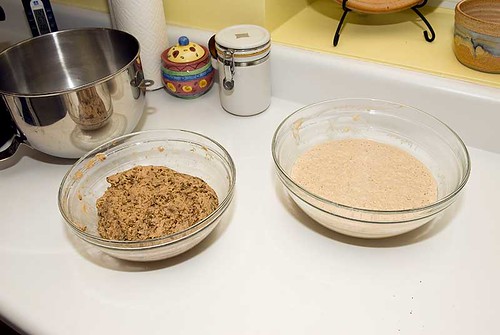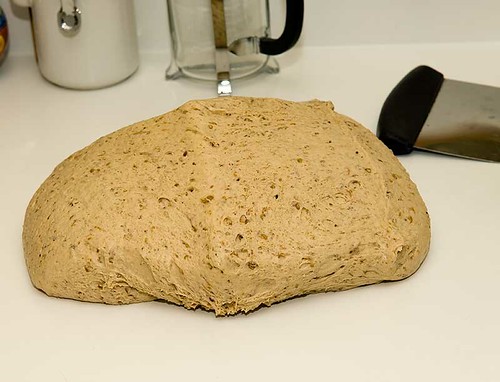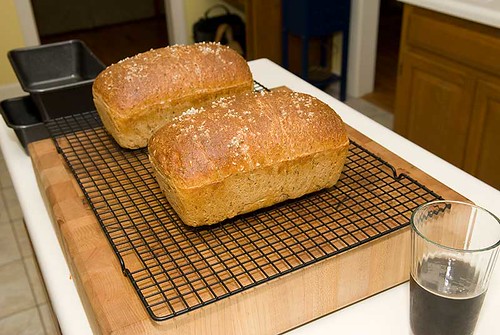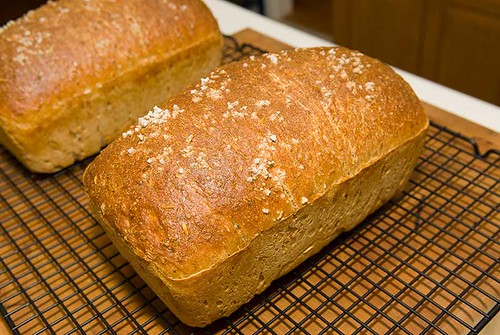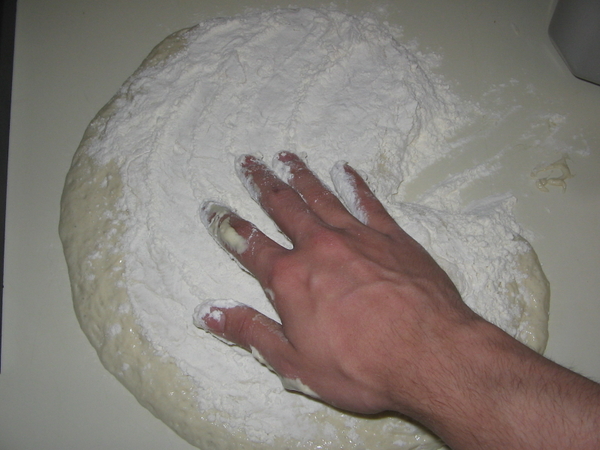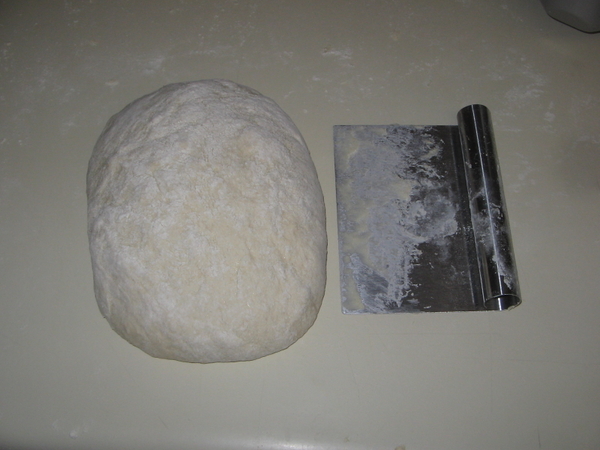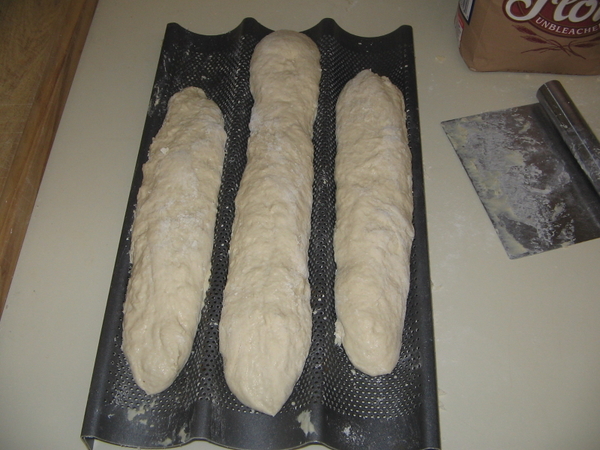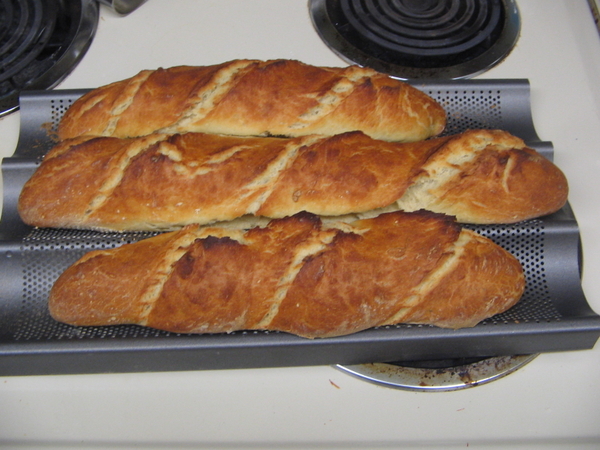orfy said:
Looks good Chad, care to share the recipe and technique?
Sure thing. As PseudoChef mentioned earlier in the thread, Peter Reinhart is a proponent of delayed fermentation and pre-ferments to extract the most possible flavor from the grains. Sounds like brewing, doesn't it? In his new book on whole grain baking he uses a couple of beermaking techniques, including mashing his flour. I took a class from him last week and it was interesting to see the parallels first hand.
Anyway, the spent grain bread doesn't use a ton of spent grains, alas, but it is a good way to re-use, recycle and enjoy something that otherwise would have been thrown on the compost heap.
Bread Profile
Slightly enriched, medium soft dough; delayed fermentation; commercial yeast or mixed commercial/sourdough optional.
Day 1
Soaker and
biga (or sourdough starter): 20 minutes to set up and mix
Day 2
2 hours to de-chill
biga; 12 to 15 minutes mixing; 2-3 hours fermentation, shaping, proofing; 40-60 minutes baking.
This recipe makes one loaf. I double it for two loaves, because it's just as easy to do two, especially if you have a stand mixer.
Soaker:
1-3/4c (8oz or 227g) whole wheat flour
1/2tsp (.14oz or 4g) salt (use almost double by volume if using kosher salt)
3/4c (6oz or 170g) water
TOTAL 14.14oz or 401g
Mix all of the soaker ingredients together in a bowl for about 1 minute until all of the flour is hydrated and ingredients form a ball. I deviate from Reinhart's recipe by adding my spent grains to the soaker -- 4oz or 113g per loaf. I figure that the mashed grains still have some active enzymes that will help convert the flour's starches to sugars.
Cover the soaker loosely with plastic wrap and leave at room temp. for 12 to 24 hours. Will last up to 3 days in the refrigerator if necessary.
Biga:
1-3/4c (8oz or 227g) whole wheat flour
1/4tsp (.03oz or 1g) instant yeast (I use SAF, it's good stuff)
3/4c (6oz or 170g) filtered or spring water
TOTAL 14.03oz or 398g
The biga differs from the soaker in the addition of yeast to begin fermentation. Mix all of the ingredients in a bowl to form a ball. Knead for about 2 minutes to make sure all of the ingredients are evenly distributed. Dough should feel very tacky. Let rest for 5 minutes to hydrate, then knead again for 1-2 minutes. Transfer to a clean bowl, cover tightly with plastic wrap and refrigerate for at least 8 hours and up to 3 days.
This is another place where I differ from Reinhart. I refresh and bulk up my sourdough starter and use that 1:1 in place of the
biga. My starter is a little wetter than the biga so I have to add a little extra flour later on. No big deal and the extra depth of flavor is worth it to me.
On day 2, about 2 hours before mixing take the biga out of the fridge and allow to come to room temperature.
Final Dough
All of the soaker 14.14oz or 401g
All of the biga or sourdough starter 14.03oz or 398g
3/4c (4oz or 113g) spent grains if you didn't add them to the soaker
Rounded teaspoon of salt (.18oz or 5g) Double this if measuring kosher salt by volume.
2-1/4tsp (.25oz or 7g) instant yeast.
2-1/2 - 3 tablespoons (1.5oz or 42.5g) honey or brown sugar (I use dark corn syrup)
1 tablespoon (.5oz or 14g) olive oil
optional
Cut the biga and the soaker into 1oz chunks (or thereabouts) with a pastry scraper. Coat with additional wheat flour to keep the pieces from sticking together.
Mix in a large bowl and stir with a heavy spoon or knead with wet hands (to keep the dough from sticking) for 2-5 minutes. If using a stand mixer, mix with the paddle attachment on low-medium. Either way, make sure the ingredients are evenly distributed and the dough has formed a slightly sticky ball. Add more flour or water as necessary. I've added as much as 3/4 cup more flour to make up for the wetness of my starter, but 5-7 tablespoons will probably do it.
Dust your work surface with flour and knead by hand (or with the dough hook on a stand mixer) for 3-5 minutes, according to Reinhart. I think he's being optimistic. I had to go 10 minutes with my stand mixer on 3 to get the satiny sheen and tacky feel that signals adequate gluten development.
Let the dough rest for at least 5 but up to 20 minutes. This will ensure proper hydration and make the dough easier to work with.
Knead for another couple of minutes, adding any additional flour or water as necessary. The dough should have strength and pass the window pane test -- pinch off a golf ball size round of dough and stretch and turn it in your fingers, almost like making a mini-pizza. You should be able to stretch the dough thin enough to see light through without it tearing. If it doesn't pass, knead some more.
Form the dough into a ball and place it in an oiled bowl. Cover loosely with plastic wrap and let rise at room temp for about an hour, until it is 1-1/2 times original size.
Turn risen dough gently onto a lightly floured work surface, pat it into rectangle and fold into thirds like folding a letter. This gently degasses the dough and gives the yeasts new sugars to munch on. Form into loaf pan shape or batards. Place dough in loaf pan, if using, otherwise place the batard on a sheet pan lined with parchment paper or a linen cloth sprinkled with flour. Spray the top of the loaf with pan spray (optional), cover loosely with plastic wrap and let rise for another 45 minutes to an hour.
Place a heavy duty sheet pan or iron skillet on the bottom rack of your oven to use as a steam pan. Pre-heat oven to 425f (218c). Pre-heat a cup of water in the microwave or on the stovetop.
When dough is ready, place loaf pan or sheet pan in the oven, pour the hot water into the steam pan, close the door and turn the oven down to 350f (177c). Be sure to cover the glass in the oven door with a towel when pouring. Even a minor splash can crack the glass.
Bake for 20 minutes, turn and bake for an additional 30 minutes. Loaf should be rich brown on all sides and register 200f (93c) in the center.
Transfer loaf to cooling rack and allow to cool for at least an hour to allow the starches to finish gelatanizing.
I brushed my loaves with an egg wash before they went into the oven. That gives a nice glossy sheen and gives the coarse salt something to stick to.
If you are into whole grain baking, Reinhart's
Whole Grain Breads is hard to beat, but fairly advanced. Still advanced but more general and covering a greater range of bread styles is
The Bread Baker's Apprentice, which is probably the best baking book out today.
Chad
Edited to clean up grammar and add that if you don't want to go to this much trouble you can probably add spent grains to just about any wheat bread recipe. The amount of spent grain can be up to 25% of the flour weight.








